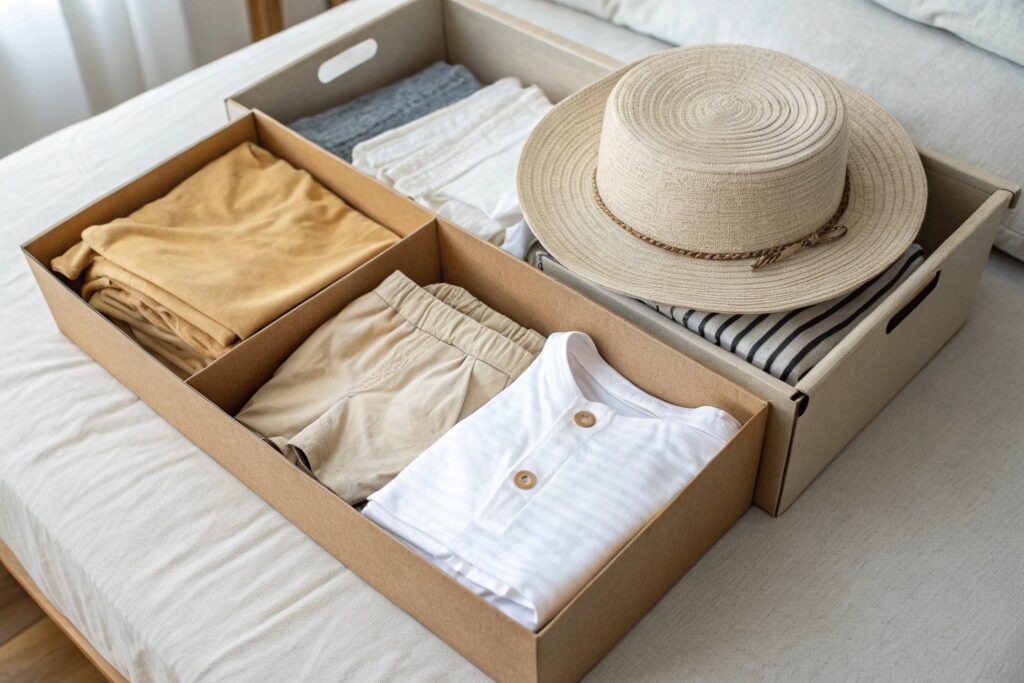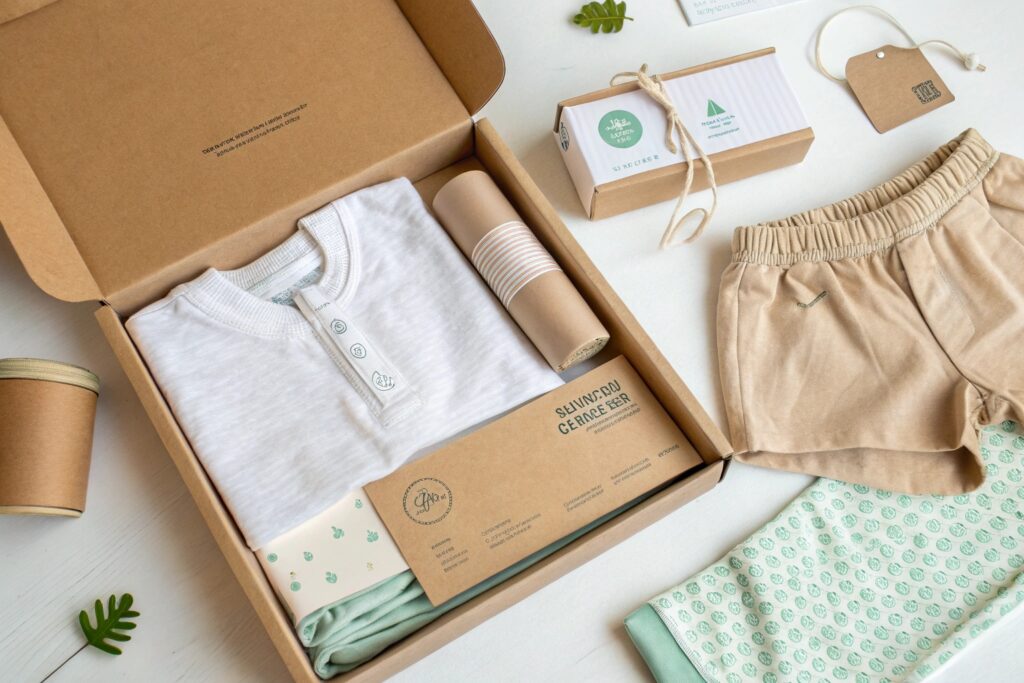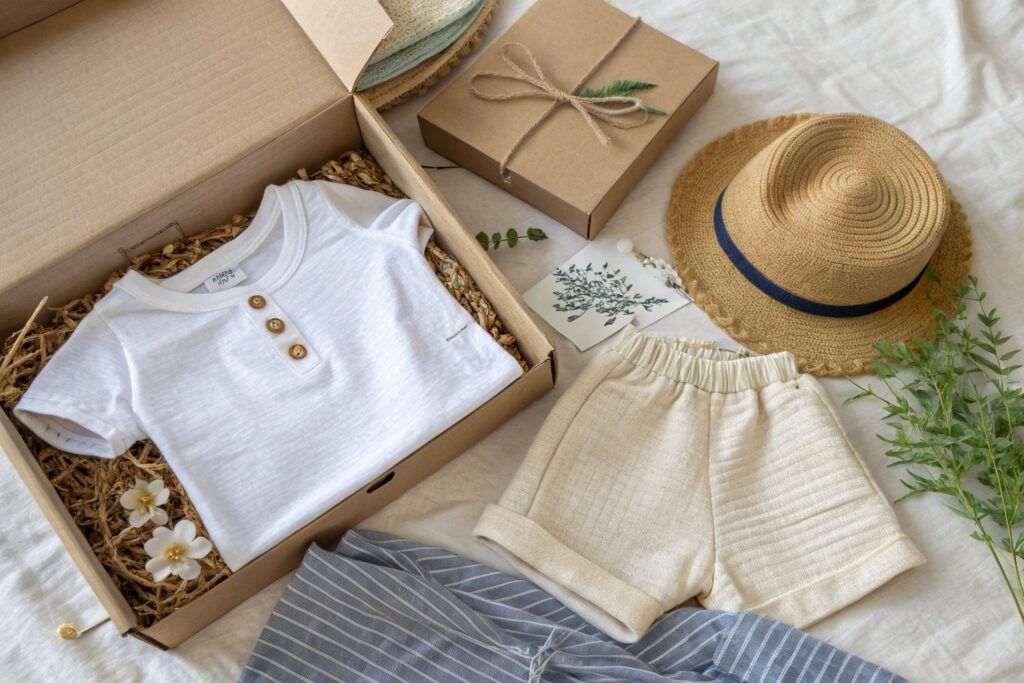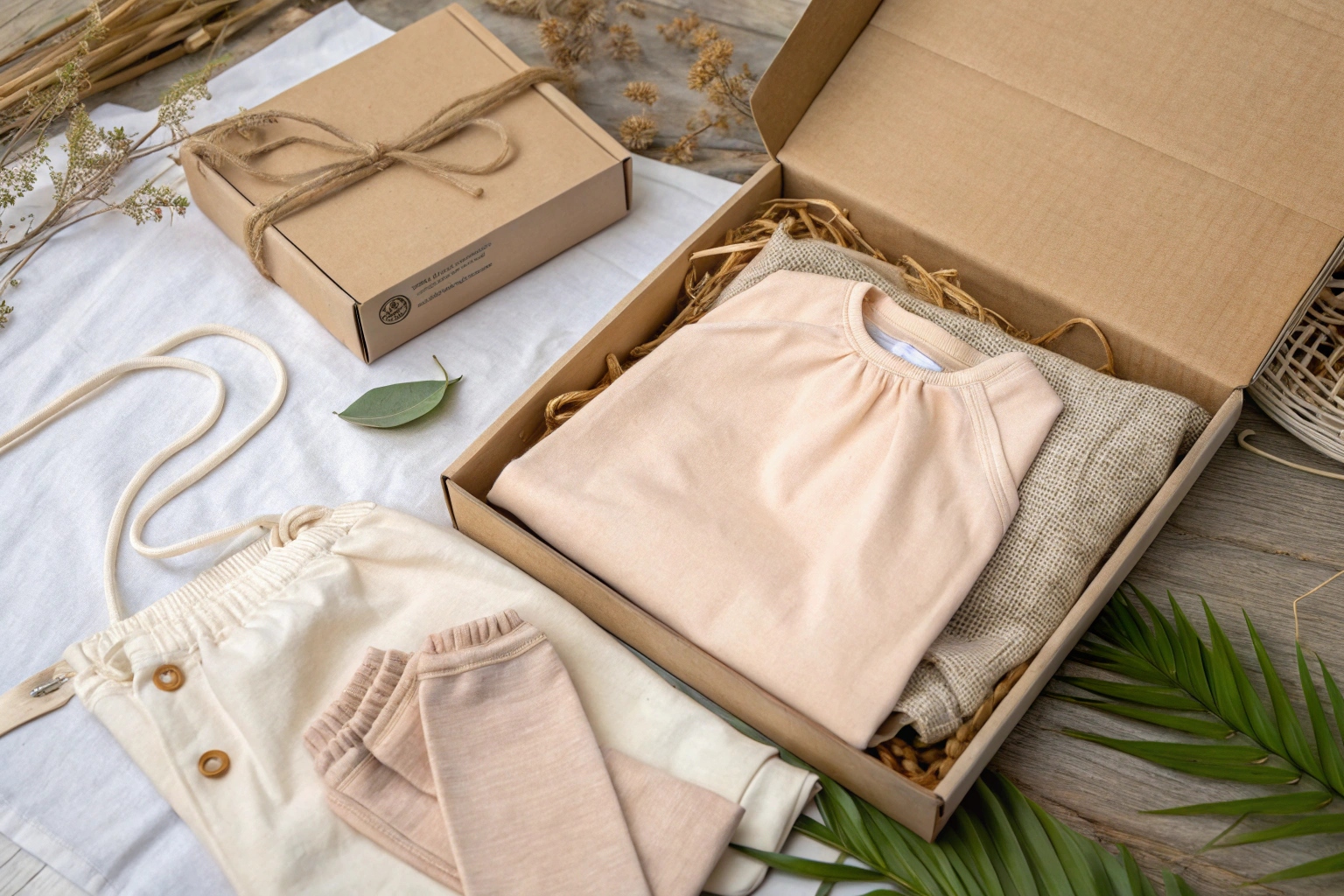Too often, sustainable kidswear is delivered in packaging that ends up in the trash—undermining the very values it promotes.
Reusable and recyclable capsule packaging protects garments, reduces environmental impact, and reinforces brand values by delivering a truly circular customer experience.
As more conscious parents seek eco-aligned products, smart packaging becomes part of the product itself. Done right, it’s not just waste-free—it’s a brand asset.
Best Materials for Sustainable Kidswear Packaging
The wrong packaging can cancel out the sustainability of everything inside it.
The best packaging materials for kidswear capsules are biodegradable, compostable, recyclable, or reusable—yet strong enough to protect garments in transit and storage.

What are the most reliable packaging materials for sustainable kidswear shipping?
We’ve tested dozens of packaging solutions for our clients and found that the most effective eco options strike a balance between protection, function, and recyclability.
Here are top-performing choices:
| Material Type | Environmental Benefit | Ideal Use |
|---|---|---|
| Kraft Paper Mailers | Fully recyclable and compostable | Lightweight capsule kits |
| Corrugated Recycled Boxes | Strong, widely recyclable | Multi-item shipments |
| Reusable Cotton Bags | Replaces plastic + adds brand value | Inner wrap for premium items |
| PLA Bio-plastic Bags | Compostable under industrial systems | Clear inner packaging if needed |
| Mushroom Packaging | Biodegradable, low-energy to produce | Protective inserts for high-end items |
At Fumao Clothing, we often recommend starting with dual-layer setups: a recycled paper mailer + a cotton drawstring pouch inside. These not only protect but enhance the unboxing experience.
Why do poly mailers—even recycled ones—often fall short of true sustainability?
Recycled plastic mailers are better than virgin plastic, but they’re still hard to recycle curbside. Most end up in landfills or incinerators. They also don’t align well with eco-conscious branding—even if printed with green graphics.
Instead, we encourage brands to shift toward compostable or multi-use options. One client using kraft mailers with soy ink saw a 23% increase in social media mentions of “eco packaging.”
If your customers are eco-minded parents, your packaging needs to match their values.
Design Tips for Reusable Capsule Wardrobe Boxes
A good capsule box doesn’t just deliver clothing—it stores it, organizes it, and encourages reuse.
Reusable kidswear packaging should be sturdy, modular, and child-friendly, allowing families to repurpose it for storage, gifting, or future capsule organization.

What structural elements turn a box from single-use into multi-functional?
We’ve helped brands design packaging that lives far beyond the unboxing moment. Here’s what works:
- Rigid foldable walls: Keep shape for reuse as toy or clothing storage
- Magnetic closures or snap lids: Replace tape or glue flaps
- Interior dividers: Encourage capsule sorting (tops, bottoms, accessories)
- Flat-pack ability: For easy storage between uses
- Child-safe finishes: No sharp edges or toxic adhesives
A European client used our FSC-certified magnetic boxes to double as keepsake containers. Customers loved the added utility, and return rates fell due to better perceived value.
Capsule packaging should be as smart and simple as the wardrobe it carries.
How does branded reusable packaging build long-term customer loyalty?
Eco-conscious customers don’t just want sustainability—they want meaning. Packaging that’s useful earns a permanent place in their home.
We recommend subtle branding: embossed logos, printed care instructions, or “reuse me” tags with QR codes linking to organization tips. Some brands even include stickers kids can use to personalize their boxes.
One partner brand introduced a capsule “passport” insert—a mini booklet for parents to log the items, track growth sizes, and pass the capsule on later. It became a signature piece, talked about in reviews.
When packaging tells a story, customers remember it.
How to Make Kidswear Packaging Fully Recyclable
Recyclability isn’t automatic—it depends on smart design choices and compatible materials.
To make kidswear packaging fully recyclable, eliminate mixed materials, avoid lamination and non-removable plastic parts, and clearly label recycling instructions for consumers.

What common packaging features make recycling harder or impossible?
Even well-meaning packaging can fail if it mixes materials that can’t be separated. Watch out for:
- Plastic windows in paper boxes
- Glossy lamination or UV coatings
- Metal grommets or magnets
- Non-compostable glues and tapes
- Overuse of color or wax-based ink
We design with mono-material principles—meaning every component can be processed in the same stream. For example, switching from a poly sticker seal to a kraft paper tab keeps the whole box compostable.
One of our partners removed all plastic tape and swapped to paper strips with starch glue. Their packaging became 98% recyclable—and customer feedback praised the ease.
How can brands improve recycling participation among consumers?
Recyclability is only effective if users know what to do. We advise:
- Clear, visible instructions on the mailer or box
- Minimal mixed-color printing to improve fiber quality
- QR codes linking to local recycling tips
- Brand incentives for returning or reusing packaging
A U.S. babywear company we work with includes a printed badge on every box: “This box is 100% recyclable. Please flatten and recycle curbside.” That small nudge raised reported recycling rates by 37%.
Education transforms intent into action. Make it easy—and visual.
Eco Packaging Solutions Loved by Conscious Brands
Some of the most admired kidswear brands lead the way not just in product, but in presentation.
Top sustainable kidswear brands embrace eco-packaging that’s minimal, multi-use, plastic-free, and beautiful enough to photograph—because conscious customers share what they love.

What brands are setting a standard in sustainable capsule packaging?
Here are standout examples we follow:
| Brand | Packaging Strategy | Customer-Facing Eco Features |
|---|---|---|
| Hanna Andersson | Recyclable kraft shipping bags | Printed recycling symbols + care insert |
| Quincy Mae | Organic cotton pouches in kraft boxes | Compostable bags + minimalist graphics |
| Fin & Vince | Gift-style boxes with string closures | Paper-only packaging, no synthetic fillers |
| Mightly | Flat mailers made from 100% post-consumer paper | FSC certified, soy-based inks |
| Petit Collage | Reusable cardboard tubes and collapsible bins | Stackable for toy storage after use |
Many of these brands also use Fumao-sourced packaging materials tailored for capsule sets. We help brands match their sustainability claims with a packaging experience that’s functional and photo-ready.
How can small or emerging brands adopt premium eco-packaging without blowing their budget?
Start simple. You don’t need custom-printed boxes to be effective.
- Use unbranded kraft mailers + custom stickers
- Offer branded pouches as value-add for larger orders
- Include a “reuse me” card or capsule checklist inside
- Bundle garments with twine or compostable ribbon, not poly bags
At Fumao Clothing, we offer low-MOQ packaging solutions designed specifically for small capsule collections. Our goal is to help brands grow into sustainability—not get priced out of it.
Smart, scalable packaging makes a big brand impact.
Conclusion
Truly sustainable capsule wardrobes deserve packaging that’s just as thoughtful. When boxes protect, educate, and extend the product story—they become part of the product itself.










